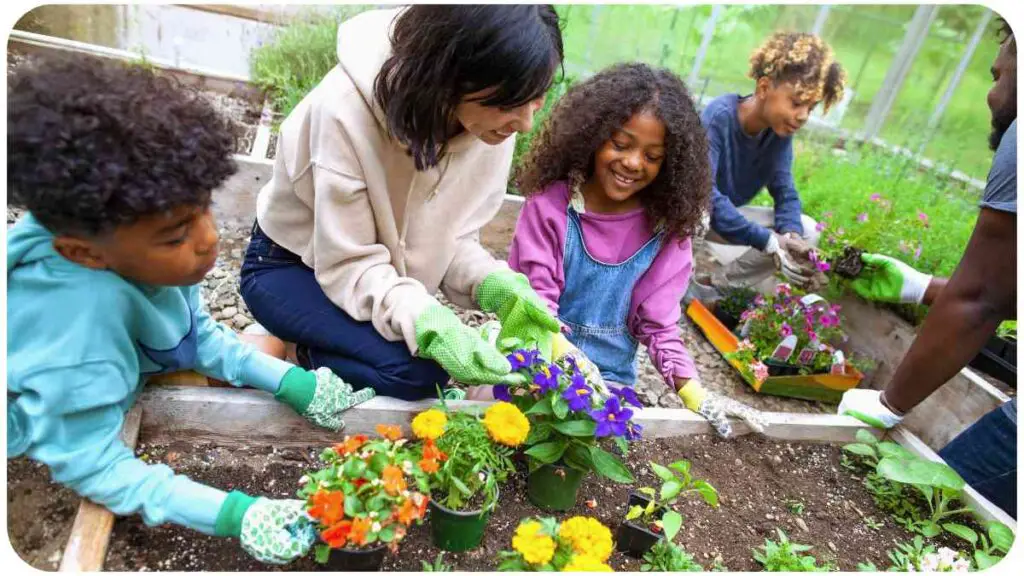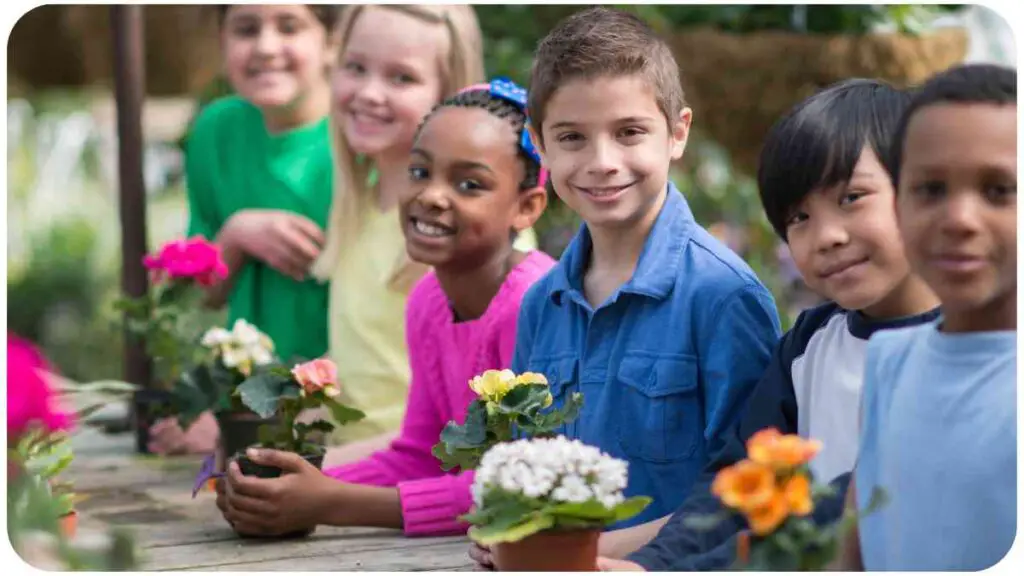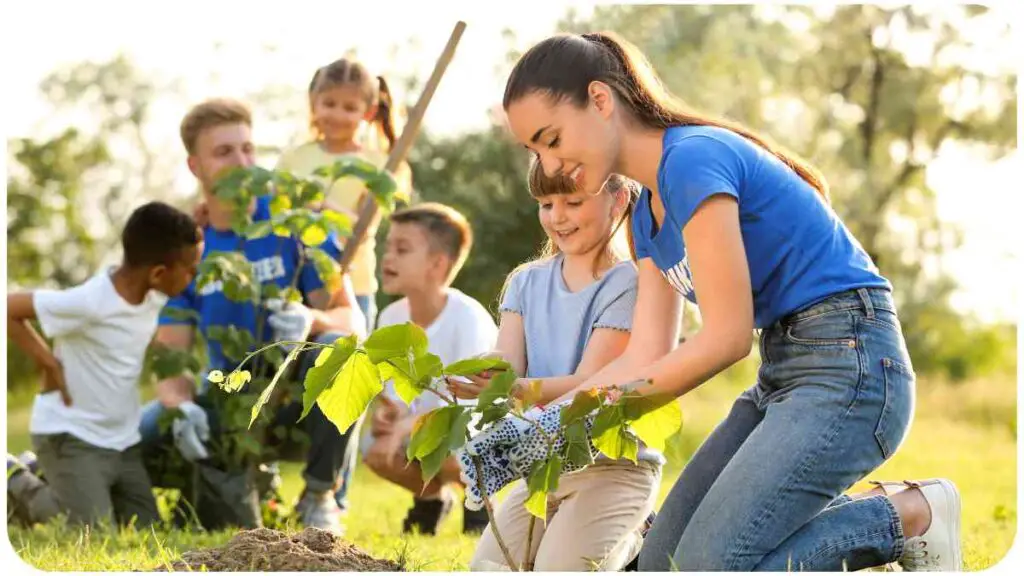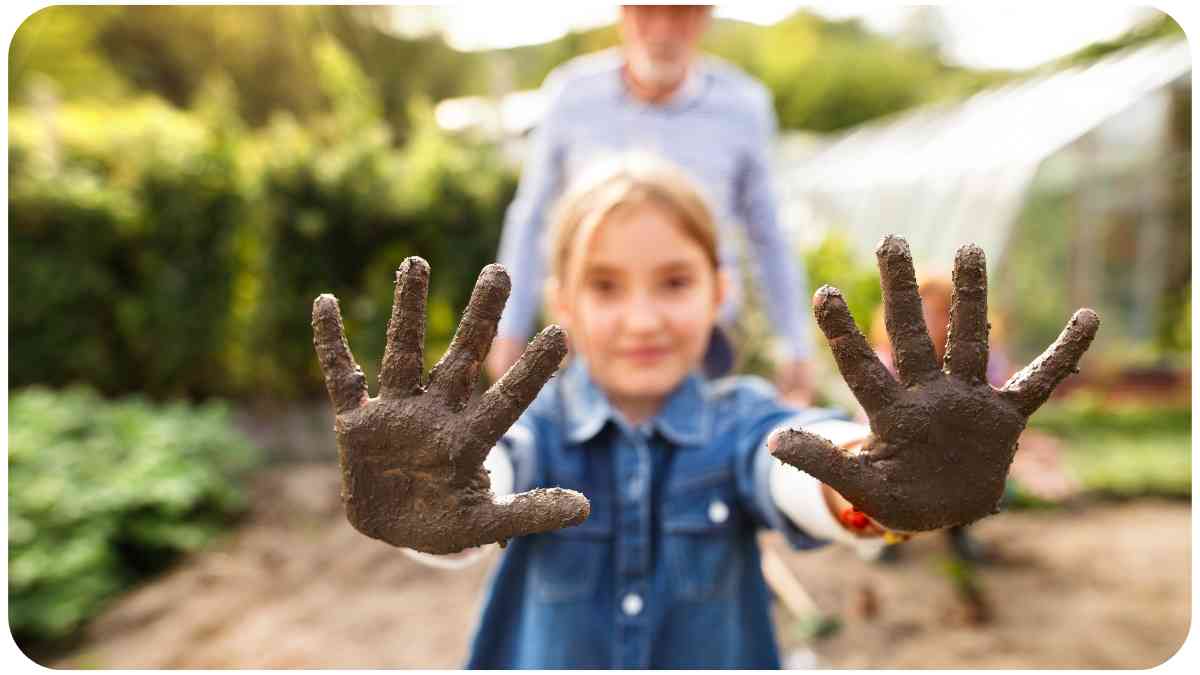Gardening isn’t just for adults; it’s a rewarding and educational activity that can captivate children’s imaginations and instill in them a love for nature. In this article, we’ll explore the world of kids’ gardening and how it can nurture a lifelong appreciation for the environment.
2. The Benefits of Kids’ Gardening
Table: Benefits of Kids’ Gardening
| Benefit | Description |
|---|---|
| 1. Enhances Learning | Engages children in hands-on learning about plants, ecosystems, and the natural world. |
| 2. Encourages Healthy Eating | Promotes healthy eating habits by growing fruits, vegetables, and herbs that children can harvest. |
| 3. Fosters Responsibility | Teaches responsibility as children care for plants and observe the effects of their actions on growth. |
| 4. Boosts Physical Activity | Provides opportunities for physical activity through digging, planting, watering, and harvesting. |
| 5. Cultivates Patience | Develops patience and perseverance as children wait for seeds to sprout and plants to grow. |
3. Getting Started: Essential Tools and Supplies

Table: Essential Tools and Supplies for Kids’ Gardening
Transform your outdoor space into a personal haven with unique touches and greenery. Embrace nature’s serenity and create your own outdoor oasis for moments of tranquility and relaxation.
| Tool/Supply | Description |
|---|---|
| 1. Kid-Sized Tools | Smaller, lightweight tools designed for children’s hands, such as trowels, rakes, and watering cans. |
| 2. Child-Friendly Gloves | Soft, flexible gloves that protect children’s hands while allowing them to feel the soil and plants. |
| 3. Organic Seeds and Seedlings | High-quality seeds and seedlings free from harmful chemicals, suitable for children’s gardens. |
| 4. Potting Soil | Nutrient-rich soil mix formulated for container gardening, ensuring healthy plant growth. |
| 5. Watering Can | A small, easy-to-use watering can with a gentle sprinkle for watering delicate plants. |
Equipping children with the right tools and supplies is essential to their enjoyment and success in gardening. Kid-sized tools make it easier for them to handle tasks independently, while child-friendly gloves protect their hands and foster a sense of ownership over their garden.
4. Choosing the Right Plants for Kids
Table: Easy-to-Grow Plants for Kids’ Gardens
| Plant | Description |
|---|---|
| 1. Sunflowers | Fast-growing and vibrant flowers that can reach impressive heights, delighting children. |
| 2. Cherry Tomatoes | Small, sweet tomatoes that are easy to grow in containers and perfect for snacking. |
| 3. Strawberries | Juicy, flavorful berries that can be grown in hanging baskets or garden beds. |
| 4. Basil | Fragrant herb that thrives in containers and adds flavor to homemade pizzas and pasta. |
| 5. Marigolds | Colorful flowers that repel pests and attract beneficial insects to the garden. |
Choosing plants that are easy to grow and visually appealing can spark children’s interest and keep them engaged in the gardening process. Sunflowers, cherry tomatoes, and strawberries are popular choices for their rapid growth and delicious rewards.
Escape the hustle and bustle by crafting a backyard retreat that soothes the soul. Design your tranquil haven with natural elements and cozy corners, perfect for unwinding after a long day.
5. Creating a Kid-Friendly Garden Space

When designing a garden for children, it’s important to create a space that is both inviting and accessible to them. Here are some tips for creating a kid-friendly garden space:
- Designate a Dedicated Area: Set aside a specific area of the garden that belongs to the children. This could be a raised bed, a corner of the yard, or even a few pots on a patio or balcony.
- Include Play Elements: Integrate play elements into the garden design, such as stepping stones, a small playhouse, or a mini sandbox. These features will encourage children to spend time outdoors and engage in imaginative play.
- Create Paths and Walkways: Define pathways with colorful stones, bricks, or mulch to guide children through the garden and create a sense of exploration.
- Add Seating: Provide kid-sized seating options, such as small benches or colorful bean bags, where children can relax and observe their garden.
- Incorporate Art and Decor: Hang bird feeders, wind chimes, or colorful banners to add visual interest and attract wildlife to the garden.
By incorporating these elements into the garden design, you can create a space that is not only educational but also fun and engaging for children.
6. Gardening Activities for Kids
Gardening offers a wealth of hands-on activities that children of all ages can enjoy. Here are some fun gardening activities to try with kids:
Table: Fun Gardening Activities for Kids
| Activity | Description |
|---|---|
| 1. Planting Seeds | Let children sow seeds in pots or garden beds, teaching them about planting depth and spacing. |
| 2. Watering Plants | Show children how to water plants gently and evenly, emphasizing the importance of hydration for growth. |
| 3. Weeding | Task children with removing weeds from the garden, teaching them to differentiate between weeds and plants. |
| 4. Harvesting Produce | Involve children in harvesting ripe fruits, vegetables, and herbs, celebrating the fruits of their labor. |
| 5. Garden Crafts | Encourage children to get creative with garden-themed crafts, such as painting rocks or making seed bombs. |
Engaging children in these activities not only teaches them valuable gardening skills but also fosters a deeper connection to nature and the food they eat.
Indulge your creativity with delightful DIY backyard projects that enhance your outdoor living space. From charming garden decor to functional furniture, explore 10 inspiring ideas to elevate your backyard ambiance.
7. Teaching Kids About Sustainability and Environmental Awareness
Kids’ gardening presents a unique opportunity to instill values of sustainability and environmental awareness from a young age. Here’s how you can incorporate these important lessons into gardening activities:
- Composting: Teach children about the importance of composting and how organic waste can be recycled into nutrient-rich soil for their garden. Encourage them to collect kitchen scraps, yard waste, and other compostable materials to create their own compost pile.
- Water Conservation: Demonstrate the importance of water conservation by encouraging children to water plants efficiently, using watering cans or drip irrigation systems. Discuss the impact of water scarcity on plants, animals, and ecosystems, and explore strategies for conserving water in the garden and beyond.
- Pollinator Protection: Educate children about the role of pollinators, such as bees, butterflies, and birds, in the garden ecosystem. Plant flowers that attract pollinators and discuss the importance of protecting these essential creatures through habitat preservation and pesticide-free gardening practices.
- Waste Reduction: Explore ways to reduce waste in the garden, such as using organic mulches to suppress weeds, practicing companion planting to deter pests naturally, and reusing materials for garden projects and decorations.
By integrating these sustainability lessons into kids’ gardening activities, you can empower children to become stewards of the environment and advocates for positive change in their communities.
8. Overcoming Challenges in Kids’ Gardening
While kids’ gardening is incredibly rewarding, it’s not without its challenges. Here are some common obstacles you may encounter and strategies for overcoming them:
- Limited Attention Span: Children may quickly lose interest in gardening if activities become repetitive or tedious. Keep things engaging by introducing new plants, experiments, or challenges to pique their curiosity.
- Pests and Diseases: Garden pests and diseases can wreak havoc on plants and frustrate young gardeners. Teach children about common pests and diseases, and involve them in pest management strategies, such as hand-picking pests or using natural predators like ladybugs.
- Weather Conditions: Extreme weather conditions, such as heatwaves, heavy rain, or frost, can damage plants and disrupt gardening activities. Monitor weather forecasts and plan accordingly, providing protection for sensitive plants and adjusting gardening tasks as needed.
- Space Limitations: Not everyone has access to a spacious backyard for gardening. If space is limited, get creative with container gardening, vertical gardening, or community garden plots to maximize growing space and engage children in hands-on gardening experiences.
9. Celebrating Success: Rewards and Recognition
Celebrating the achievements and milestones of young gardeners is essential for nurturing their passion and confidence. Here are some ways to recognize and reward their efforts in the garden:
- Harvest Celebrations: Host harvest celebrations to mark the culmination of months of hard work and dedication. Invite family and friends to join in the festivities and enjoy the fruits of the children’s labor together.
- Certificate of Achievement: Create personalized certificates or awards to recognize children for their contributions to the garden. Highlight specific accomplishments, such as successfully growing a plant from seed or maintaining a garden bed throughout the season.
- Garden Show-and-Tell: Organize a garden show-and-tell event where children can showcase their favorite plants, share gardening tips, and talk about their experiences in the garden. Encourage them to express themselves creatively through presentations, artwork, or storytelling.
- Photo Documentation: Document children’s gardening journey through photos and videos, capturing memorable moments and milestones along the way. Create a scrapbook or digital photo album that children can look back on with pride and nostalgia.
- Community Recognition: Recognize children’s gardening achievements within the community by sharing their stories and successes through local newspapers, social media, or community newsletters. Highlight the positive impact they’re making on the environment and inspire others to get involved in gardening.
By celebrating success and providing positive reinforcement, you can cultivate a sense of accomplishment and belonging in young gardeners, motivating them to continue exploring and learning in the garden.
Gather friends and family for outdoor entertainment in a space designed for enjoyment. Discover tips for embracing outdoor entertaining with cozy seating, ambient lighting, and delicious cuisine under the open sky.
10. Inspiring Stories: Real-Life Examples of Kids’ Gardening Triumphs
Real-life success stories serve as powerful inspiration for young gardeners, demonstrating the possibilities and potential of kids’ gardening. Here are a few examples of children who have made a difference through their gardening adventures:
- Emma Biggs: At just nine years old, Emma Biggs co-authored the book “Grow Gardeners” and became a passionate advocate for kids’ gardening. She shares her gardening journey and tips for young gardeners through her website and social media platforms, inspiring children around the world to get their hands dirty and grow their own food.
- Green Bronx Machine: The Green Bronx Machine is a school gardening program founded by educator Stephen Ritz in the South Bronx, New York. Through hands-on gardening activities, Ritz has empowered students to cultivate nutritious food, develop job skills, and transform their community one garden at a time.
- Little Green Thumbs: Little Green Thumbs is a national school gardening program in Canada that engages over 40,000 students each year in hands-on gardening activities. By integrating gardening into the curriculum, the program fosters environmental stewardship, healthy eating habits, and a love for nature among children of all ages.
These inspiring stories demonstrate the transformative power of kids’ gardening and the profound impact it can have on children’s lives, communities, and the planet. By sharing these success stories with young gardeners, you can ignite their passion and belief in their ability to make a difference through gardening.
11. Incorporating Kids’ Gardening into Education

Kids’ gardening offers a wealth of educational opportunities that can be seamlessly integrated into school curricula across various subjects. Here’s how you can incorporate gardening into education:
- Science: Gardening provides a hands-on approach to learning about plant biology, ecology, and environmental science. Students can observe the life cycle of plants, investigate soil composition and pH levels, and explore the interactions between plants, animals, and microorganisms in the garden ecosystem.
- Mathematics: Gardening offers practical applications for math concepts such as measurement, estimation, and data analysis. Students can calculate the area of garden beds, measure plant growth over time, and graph temperature or rainfall data to understand seasonal patterns.
- Language Arts: Gardening provides rich opportunities for literacy development through reading, writing, and storytelling. Students can read informational texts about plants and gardening techniques, write descriptive essays or journal entries about their gardening experiences, and create multimedia presentations to share their knowledge with others.
- Social Studies: Gardening offers insights into cultural practices, food systems, and community engagement. Students can explore the historical significance of plants and agriculture in different cultures, examine issues related to food security and sustainability, and collaborate on garden-based service projects that benefit their local community.
- Art and Creativity: Gardening encourages creativity and artistic expression through garden design, plant selection, and garden-themed artwork. Students can design garden layouts, paint plant markers or garden signs, and create nature-inspired art using materials found in the garden.
By integrating gardening into education, teachers can engage students in hands-on, experiential learning that fosters curiosity, critical thinking, and a deeper connection to the natural world.
12. Engaging the Community: Group Gardening Projects
Gardening presents an opportunity to bring communities together and foster collaboration among people of all ages and backgrounds. Here are some ideas for engaging the community in group gardening projects:
- Community Gardens: Establish community gardens in public spaces or vacant lots where residents can come together to grow fruits, vegetables, and flowers. Community gardens provide access to fresh, locally grown produce, promote healthy eating habits, and create opportunities for social interaction and neighborhood revitalization.
- School Gardening Programs: Collaborate with local schools to develop gardening programs that engage students, teachers, and parents in hands-on learning activities. School gardens can serve as outdoor classrooms where students learn about plant science, nutrition, and environmental stewardship while cultivating food and beautifying the school grounds.
- Volunteer Workdays: Organize volunteer workdays where community members can come together to help maintain public gardens, parks, or green spaces. Tasks may include planting, weeding, watering, and mulching, providing an opportunity for people to connect with nature and contribute to the well-being of their community.
- Garden Tours and Workshops: Host garden tours and workshops to showcase successful gardening projects and share tips and techniques with community members. Topics may include organic gardening practices, composting, container gardening, and attracting pollinators to the garden.
By engaging the community in group gardening projects, you can foster a sense of belonging, strengthen social ties, and promote environmental stewardship and civic engagement.
If you’re interested in organizing a community gardening project or need guidance on how to get started, feel free to reach out to local gardening organizations or extension offices for support and resources.
Build a sustainable garden paradise that thrives in harmony with nature’s cycles. Learn the principles of permaculture and create your self-sustaining utopia where plants, animals, and people coexist in balance.
13. Tips for Parents and Educators
Whether you’re a parent or an educator, nurturing a love for gardening in children requires patience, creativity, and a willingness to get your hands dirty. Here are some tips to help you inspire and support young gardeners:
- Start Small: Begin with simple gardening projects that are manageable for children’s attention spans and abilities. Plant fast-growing seeds like beans or radishes in containers or small garden beds to provide quick results and keep kids engaged.
- Make It Fun: Incorporate games, storytelling, and hands-on activities into gardening to make it enjoyable for children. Turn weeding into a treasure hunt, create a sensory garden with plants that appeal to different senses, or host a garden-themed scavenger hunt to explore the wonders of nature.
- Lead by Example: Be a role model for children by demonstrating enthusiasm and curiosity in the garden. Get involved in gardening tasks alongside them, share your own gardening experiences and knowledge, and celebrate successes together.
- Encourage Exploration: Allow children to explore and experiment in the garden, even if it means making mistakes along the way. Encourage them to ask questions, make observations, and discover the magic of nature firsthand.
- Provide Guidance: Offer guidance and support as children learn new gardening skills and techniques. Teach them how to handle tools safely, demonstrate proper planting and watering techniques, and provide gentle reminders to care for their plants regularly.
- Embrace Learning Opportunities: Use gardening as a platform for interdisciplinary learning, incorporating concepts from science, math, language arts, and social studies into gardening activities. Encourage children to ask questions, conduct experiments, and engage in critical thinking as they explore the natural world.
- Celebrate Achievements: Recognize and celebrate children’s gardening achievements, no matter how small. Praise their efforts, showcase their accomplishments, and create opportunities for them to share their gardening experiences with others.
By following these tips, you can create a positive and supportive environment that encourages children to explore, learn, and grow through gardening.
14. Conclusion
Kids’ gardening is more than just a hobby; it’s a transformative experience that nurtures curiosity, instills values, and fosters a deeper connection to the natural world. Whether in a backyard, schoolyard, or community garden, children can discover the joy of planting seeds, watching them grow, and harvesting the fruits of their labor.
As parents, educators, and community members, we have the power to cultivate a love for gardening in the next generation and inspire them to become stewards of the environment and champions of sustainability. By providing children with opportunities to get their hands dirty, explore the wonders of nature, and make meaningful connections with the world around them, we can sow the seeds for a brighter, greener future.
So, roll up your sleeves, grab a shovel, and join us on this gardening adventure. Together, we can nurture nature’s love and cultivate a generation of young gardeners who are ready to change the world one seed at a time.
Further Reading
- Drought Busting Techniques: Explore drought-busting techniques for maintaining a healthy garden during dry spells.
- Organic Gardening for Kids: Learn about the benefits of organic gardening for children and how to incorporate sustainable practices into kids’ gardening activities.
- What Gardening with My Child Has Taught Me: Discover heartfelt insights and lessons learned from gardening with children, including the joys of connecting with nature and finding beauty in the little things.
FAQs
How can I encourage my child to get involved in gardening?
Encourage your child’s interest in gardening by involving them in choosing plants, providing kid-friendly tools, and making gardening fun with games and activities.
What are some easy-to-grow plants for children’s gardens?
Sunflowers, cherry tomatoes, strawberries, basil, and marigolds are all easy-to-grow plants that children can enjoy cultivating in their gardens.
How can I make gardening educational for my child?
Make gardening educational by teaching children about plant biology, ecosystems, sustainability, and environmental stewardship through hands-on activities and experiential learning.
What are the benefits of gardening for children?
Gardening offers numerous benefits for children, including opportunities for hands-on learning, fostering a connection to nature, promoting healthy eating habits, and teaching responsibility and patience.
How can I overcome challenges in gardening with my child?
Overcome challenges in gardening with your child by starting small, embracing learning opportunities, providing guidance and support, and celebrating achievements together.

For 15 years, Hellen James has worked in the gardening industry as an expert and landscape designer. During her career, she has worked for a variety of businesses that specialize in landscaping and gardening from small firms to large corporations.

